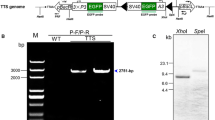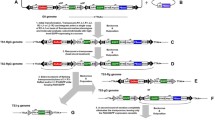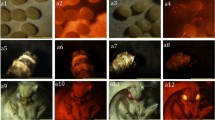Abstract
Cre-mediated recombination is widely used to manipulate defined genes spatiotemporally in vivo. The present study evaluated the Cre/loxP system in Bombyx mori by establishing two transgenic lines. One line contained a Cre recombinase gene controlled by a sericin-1 gene (Ser1) promoter. The other line contained a loxP-Stop-loxP-DsRed cassette driven by the same Ser1 promoter. The precise deletion of the Stop fragment was found to be triggered by Cre-mediated site-specific excision, and led to the expression of DsRed fluorescence protein in the middle silk glands of all double-transgenic hybrids. This result was also confirmed by phenotypical analysis. Hence, the current study demonstrated the feasibility of Cre-mediated site-specific recombination in B. mori, and opened a new window for further refining genetic tools in silkworms.







Similar content being viewed by others
Abbreviations
- Ser1 :
-
Sericin-1 gene
- floxed:
-
Flanked by two loxP sites
- RFP:
-
DsRed fluorescence protein
- pA:
-
SV40 polyadenylation signal
- AMSG:
-
Anterior subpart of middle silk gland
- MMSG:
-
Middle subpart of middle silk gland
- PMSG:
-
Posterior subpart of middle silk gland
- MSG:
-
Middle silk gland
- PSG:
-
Posterior silk gland
References
Albert H, Dale EC, Lee E, Ow DW (1995) Site-specific integration of DNA into wild-type and mutant lox sites placed in the plant genome. Plant J 7(4):649–659
Branda CS, Dymecki SM (2004) Talking about a revolution: the impact of site-specific recombinases on genetic analyses in mice. Dev Cell 6(1):7–28. doi:S153458070300399X
Buchholz F, Ringrose L, Angrand PO, Rossi F, Stewart AF (1996) Different thermostabilities of FLP and Cre recombinases: implications for applied site-specific recombination. Nucleic Acids Res 24(21):4256–4262. doi:10.1093/nar/24.21.4256
Gage LP (1974) Polyploidization of the silk gland of Bombyx mori. J Mol Biol 86(1):97–108
Garrick D, Fiering S, Martin DI, Whitelaw E (1998) Repeat-induced gene silencing in mammals. Nat Genet 18(1):56–59. doi:10.1038/ng0198-56
Golic KG, Golic MM (1996) Engineering the Drosophila genome: chromosome rearrangements by design. Genetics 144(4):1693–1711
Gong WJ, Golic KG (2003) Ends-out, or replacement, gene targeting in Drosophila. Proc Natl Acad Sci USA 100(5):2556–2561. doi:10.1073/pnas.0535280100
Gu H, Marth JD, Orban PC, Mossmann H, Rajewsky K (1994) Deletion of a DNA polymerase beta gene segment in T cells using cell type-specific gene targeting. Science 265(5168):103–106
Herault Y, Rassoulzadegan M, Cuzin F, Duboule D (1998) Engineering chromosomes in mice through targeted meiotic recombination (TAMERE). Nat Genet 20(4):381–384. doi:10.1038/3861
Herrera PL (2000) Adult insulin- and glucagon-producing cells differentiate from two independent cell lineages. Development 127(11):2317–2322
Hoa TT, Bong BB, Huq E, Hodges TK (2002) Cre/lox site-specific recombination controls the excision of a transgene from the rice genome. Theor Appl Genet 104(4):518–525. doi:10.1007/s001220100748
Horn C, Wimmer EA (2000) A versatile vector set for animal transgenesis. Dev Genes Evol 210(12):630–637
Imamura M, Nakai J, Inoue S, Quan GX, Kanda T, Tamura T (2003) Targeted gene expression using the GAL4/UAS system in the silkworm Bombyx mori. Genetics 165(3):1329–1340
Indra AK, Warot X, Brocard J, Bornert JM, Xiao JH, Chambon P, Metzger D (1999) Temporally-controlled site-specific mutagenesis in the basal layer of the epidermis: comparison of the recombinase activity of the tamoxifen-inducible Cre-ER(T) and Cre-ER(T2) recombinases. Nucleic Acids Res 27(22):4324–4327. doi:10.1093/nar/27.22.4324
Isobe R, Kojima K, Matsuyama T, Quan GX, Kanda T, Tamura T, Sahara K, Asano SI, Bando H (2004) Use of RNAi technology to confer enhanced resistance to BmNPV on transgenic silkworms. Arch Virol 149(10):1931–1940
Kozak M (1991) Structural features in eukaryotic mRNAs that modulate the initiation of translation. J Biol Chem 266(30):19867–19870
Lakso M, Sauer B, Mosinger B Jr, Lee EJ, Manning RW, Yu SH, Mulder KL, Westphal H (1992) Targeted oncogene activation by site-specific recombination in transgenic mice. Proc Natl Acad Sci USA 89(14):6232–6236
Lam KP, Rajewsky K (1998) Rapid elimination of mature autoreactive B cells demonstrated by Cre-induced change in B cell antigen receptor specificity in vivo. Proc Natl Acad Sci USA 95(22):13171–13175
Liu Y, Yu L, Guo X, Guo T, Wang S, Lu C (2006) Analysis of tissue-specific region in sericin 1 gene promoter of Bombyx mori. Biochem Biophys Res Commun 342(1):273–279. doi:S0006-291X(06)00236-1
Matsuno K, Hui CC, Takiya S, Suzuki T, Ueno K, Suzuki Y (1989) Transcription signals and protein binding sites for sericin gene transcription in vitro. J Biol Chem 264(31):18707–18713
Nagy A, Moens C, Ivanyi E, Pawling J, Gertsenstein M, Hadjantonakis AK, Pirity M, Rossant J (1998) Dissecting the role of N-myc in development using a single targeting vector to generate a series of alleles. Curr Biol 8(11):661–664. doi:S0960-9822(98)70254-4
Nakayama G, Kawaguchi Y, Koga K, Kusakabe T (2006) Site-specific gene integration in cultured silkworm cells mediated by φC31 integrase. Mol Genet Genomics 275(1):1–8. doi:10.1007/s00438-005-0026-3
O’Gorman S, Fox DT, Wahl GM (1991) Recombinase-mediated gene activation and site-specific integration in mammalian cells. Science 251(4999):1351–1355
Perdrix-Gillot S (1979) DNA synthesis and endomitoses in the giant nuclei of the silkgland of Bombyx mori. Biochimie 61(2):171–204
Quan GX, Kanda T, Tamura T (2002) Induction of the white egg 3 mutant phenotype by injection of the double-stranded RNA of the silkworm white gene. Insect Mol Biol 11(3):217–222. doi:10.1046/j.13652583.2002.00328.x
Rong YS, Golic KG (2001) A targeted gene knockout in Drosophila. Genetics 157(3):1307–1312
Sauer B (1987) Functional expression of the cre-lox site-specific recombination system in the yeast Saccharomyces cerevisiae. Mol Cell Biol 7(6):2087–2096
Suzuki MG, Funaguma S, Kanda T, Tamura T, Shimada T (2003) Analysis of the biological functions of a doublesex homologue in Bombyx mori. Dev Genes Evol 213(7):345–354. doi:10.1007/s00427-003-0334-8
Tabunoki H, Higurashi S, Ninagi O, Fujii H, Banno Y, Nozaki M, Kitajima M, Miura N, Atsumi S, Tsuchida K, Maekawa H, Sato R (2004) A carotenoid-binding protein (CBP) plays a crucial role in cocoon pigmentation of silkworm (Bombyx mori) larvae. FEBS Lett 567(2–3):175–178. doi:10.1016/j.febslet.2004.04.067
Takasu Y, Hata T, Uchino K, Zhang Q (2010) Identification of Ser2 proteins as major sericin components in the non-cocoon silk of Bombyx mori. Insect Biochem Mol Biol 40(4):339–344. doi:S0965-1748(10)00039-1
Tamura T, Thibert C, Royer C, Kanda T, Abraham E, Kamba M, Komoto N, Thomas JL, Mauchamp B, Chavancy G, Shirk P, Fraser M, Prudhomme JC, Couble P (2000) Germline transformation of the silkworm Bombyx mori L. using a piggyBac transposon-derived vector. Nat Biotechnol 18(1):81–84. doi:10.1038/71978
Tan A, Tanaka H, Tamura T, Shiotsuki T (2005) Precocious metamorphosis in transgenic silkworms overexpressing juvenile hormone esterase. Proc Natl Acad Sci USA 102(33):11751–11756. doi:10.1073/pnas.0500954102
Tanimoto K, Liu Q, Bungert J, Engel JD (1999) Effects of altered gene order or orientation of the locus control region on human beta-globin gene expression in mice. Nature 398(6725):344–348. doi:10.1038/18698
Tatematsu K, Kobayashi I, Uchino K, Sezutsu H, Iizuka T, Yonemura N, Tamura T (2010) Construction of a binary transgenic gene expression system for recombinant protein production in the middle silk gland of the silkworm Bombyx mori. Transgenic Res 19(3):473–487. doi:10.1007/s11248-009-9328-2
Tateno M, Toyooka M, Shikano Y, Takeda S, Kuwabara N, Sezutsu H, Tamura T (2009) Production and characterization of the recombinant human μ-opioid receptor from transgenic silkworms. J Biochem 145(1):37–42. doi:10.1093/jb/mvn147
Thummel R, Burket CT, Brewer JL, Sarras MP Jr, Li L, Perry M, McDermott JP, Sauer B, Hyde DR, Godwin AR (2005) Cre-mediated site-specific recombination in zebrafish embryos. Dev Dyn 233(4):1366–1377. doi:10.1002/dvdy.20475
Tomita S, Kanda T, Imanishi S, Tamura T (1999) Yeast FLP recombinase-mediated excision in cultured cells and embryos of the silkworm, Bombyx mori (Lepidoptera: Bombycidae). Appl Entomol Zool 34(3):371–377
Tsien JZ, Chen DF, Gerber D, Tom C, Mercer EH, Anderson DJ, Mayford M, Kandel ER, Tonegawa S (1996) Subregion- and cell type-restricted gene knockout in mouse brain. Cell 87(7):1317–1326. doi:S0092-8674(00)81826-7
Utomo AR, Nikitin AY, Lee WH (1999) Temporal, spatial, and cell type-specific control of Cre-mediated DNA recombination in transgenic mice. Nat Biotechnol 17(11):1091–1096. doi:10.1038/15073
Vergunst AC, Jansen LE, Fransz PF, de Jong JH, Hooykaas PJ (2000) Cre/lox-mediated recombination in Arabidopsis: evidence for transmission of a translocation and a deletion event. Chromosoma 109(4):287–297
Xie HB, Golic KG (2004) Gene deletions by ends-in targeting in Drosophila melanogaster. Genetics 168(3):1477–1489. doi:10.1534/genetics.104.030882
Zhao A, Zhao T, Zhang Y, Xia Q, Lu C, Zhou Z, Xiang Z, Nakagaki M (2009) New and highly efficient expression systems for expressing selectively foreign protein in the silk glands of transgenic silkworm. Transgenic Res 19(1):29–44. doi:10.1007/s11248-009-9295-7
Acknowledgments
We thank Dr. Pedro Luis Herrera for pBS302 plasmid, Dr. Wen-Hwa Lee for pAU8-5 plasmid, and Dr. Hongjuan Cui and Dr. Shiping Liu for their critical comments on the manuscript. We also thank the Editor and reviewers for their constructive comments. The work was supported by the National Basic Research Program of China (2012CB114600), the National Hi-Tech Research and Development Program of China (2011AA100306), the National Natural Science Foundation of China (31000981) and the Graduate Innovation Foundation of Southwest University (ky2009002, kb2010002 and kb2011008).
Author information
Authors and Affiliations
Corresponding author
Additional information
Jianping Duan and Hanfu Xu contributed equally to this work.
Rights and permissions
About this article
Cite this article
Duan, J., Xu, H., Ma, S. et al. Cre-mediated targeted gene activation in the middle silk glands of transgenic silkworms (Bombyx mori). Transgenic Res 22, 607–619 (2013). https://doi.org/10.1007/s11248-012-9677-0
Received:
Accepted:
Published:
Issue Date:
DOI: https://doi.org/10.1007/s11248-012-9677-0




